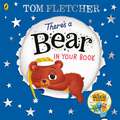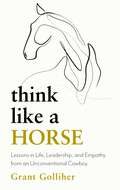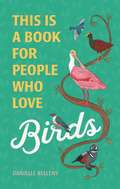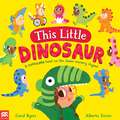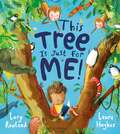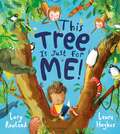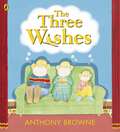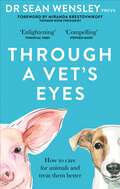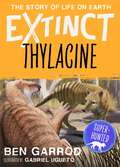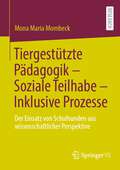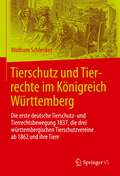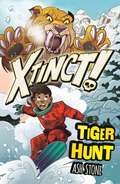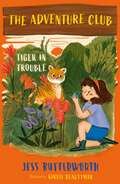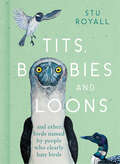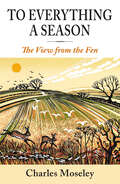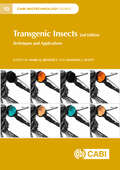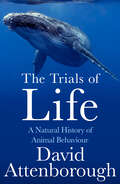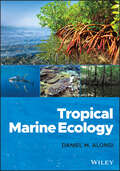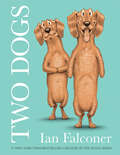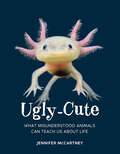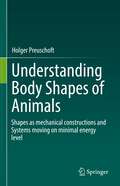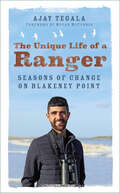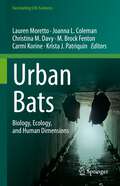- Table View
- List View
Therapeutic Applications of Mesenchymal Stem Cells in Veterinary Medicine
by Mudasir Bashir GugjooThis book reviews the potential therapeutic and reproductive applications of mesenchymal stem cells in veterinary regenerative and reproductive medicine. The systemic approach focuses on musculoskeletal structures like cartilage, bone, muscle, tendon, ligaments and nervous tissues. It also focuses on other body systems like gastrointestinal, cardiovascular, urogenital, respiratory and integumentary system. Besides, the special glands or organs like endocrine glands and eye and its adnexa are also focused. The book chapters discusses the problems and the need for regenerative medicine employing MSCs. It provides an ex vivo basis of MSCs therapeutics and reproductive potential followed by their in vivo applications. The book further provides an understanding on the behavior and mechanisms of action of mesenchymal stem cells. The book also abridges challenges and provides future prospects of mesenchymal stem cells in clinical and reproductive applications. As such, the book offers a valuable resource for students, veterinarians, and scientists working in the regenerative and reproductive sciences in human and veterinary medicine.
There's a Bear in Your Book: A soothing bedtime story from Tom Fletcher (Who's in Your Book?)
by Tom FletcherA brand new 'Who's in Your Book?' story from bestselling children's book author Tom Fletcher.OH, LOOK! A bear has wandered into your book!And - what's that noise? He's yawning! He looks like he's ready for bed.Can you help him drift off to sleep?This warm, gentle adventure combines interactive fun with a night-time routine to help little ones wind down before they go to bed.Who's in Your Book?Interactive adventures for big imaginationsAlso in this series:There's a Monster in Your Book: makes reading interactive and funThere's a Dragon in Your Book: explores empathy and responsibilityThere's an Alien in Your Book: explores acceptance and inclusionThere's an Elf in Your Book: explores following instructions and good/bad behaviourThere's a Superhero in Your Book: explores the power of kindnessThere's a Witch in Your Book: makes tidying up funThere's a Unicorn in Your Book: explores soothing your worries through sharing themThere's a Dinosaur in Your Book: helps little ones to learn about inside and outside voices
Think Like a Horse: Lessons in Life, Leadership and Empathy from an Unconventional Cowboy
by Grant GolliherDiscover the profound lessons we can learn from horses.Veteran 'horse whisperer' and communication expert, Grant Golliher, has trained thousands of horses, many of which have been traumatised or abused, and can tame a wild horse to calmly accept a saddle and a rider in just hours - without the use of any force. Through his work, Golliher has learnt essential lessons about communication, boundaries, fairness, trust and respect - lessons that apply not just to horses but to humans as well. It's why celebrities, Fortune 500 executives, professional coaches, supreme court justices, and even ordinary families from around the world flock to his Wyoming ranch every year to take part in what one CEO called 'the most transformational experience I have ever encountered'.In the decades that Golliher has been doing this work, he has seen tough and insensitive people become gentle and more empathetic, and timid and fearful people grow in firmness and confidence. Now for the first time, in Think Like a Horse, he shares fundamental and ageless lessons about life, underpinned by all he has learnt from horses. It's an approach that anyone should learn to better understand our common humanity, overcome trauma and unlock our untapped potential in all aspects of our lives.All you need to do is think like a horse.
This Is a Book for People Who Love Birds (This Is a Book for People Who Love)
by Danielle BellenyFull of bird watching basics, fun facts, and illustrated species profiles, This Is a Book for People Who Love Birds is a joyful celebration of our feathered friends!For seasoned spotters and backyard hobbyists alike, this charming guide offers an accessible look at the irresistible world of birding. Wildlife biologist and co-founder of Black Birders Week Danielle Belleny walks readers through the essentials of bird watching, from equipment to locations, offering new ideas for finding avian friends wherever you may be. Engaging profiles of North American bird species, from cardinals and blue jays to raptors and sea birds, are accompanied by whimsical illustrations sure to spark the imaginations of birders from coast to coast. Deeply researched and accessible to enthusiasts of all levels of experience, This Is a Book for People Who Love Birds is an essential addition to every bird lover's field library.
This Little Dinosaur: A Roarsome Twist on the Classic Nursery Rhyme! (This Little... #1)
by Coral ByersFollow ten little dinosaurs as they dress up, explore and more in this fun preschool counting book based on the classic nursery rhyme This Little Piggy. This little dinosaur stamps and stompsThis little dinosaur swoops and soars . . .It's dress-up time! In their colourful costumes ten excited children become noisy, roaring dinosaurs and an ordinary preschool classroom becomes a fantastical prehistorical world where anything is possible! Go along with the little dinosaurs as they stomp, swoop and roar before running all the way home!With ten children to find and count as you turn the pages, loads to spot along the way, and a special surprise fold-out ending, this picture book is specially developed for imaginative little preschool dinosaurs everywhere. There is a bonus section at the end with reading tips for parents and carers, giving ideas for discussion and extra things for children to spot.This Little Dinosaur is a riotous read-aloud preschool adventure – come and join in the fun!
This Tree is Just for Me!
by Lucy RowlandWith artwork by Laura Hughes, much-loved illustrator of the bestselling picture book, We're Going on an Egg HuntJack has a new book, and he's found the perfect place to read in peace - a big, beautiful tree. So when a tiger, a bear, an alligator and a whole host of unusual animals ask if they can join him, Jack says, 'NO! This tree is just for me!"But you've got to be careful what you wish for. When the animals go away, Jack begins to wonder whether keeping something to yourself is so much fun after all. Sometimes, a tree is EVEN better with friends in it too! This Tree is Just for Me is a charming and uplifting tale of friendship and sharing that will delight children and parents alike.
This Tree is Just for Me!
by Lucy RowlandWith artwork by Laura Hughes, much-loved illustrator of the bestselling picture book, We're Going on an Egg HuntJack has a new book, and he's found the perfect place to read in peace - a big, beautiful tree. So when a tiger, a bear, an alligator and a whole host of unusual animals ask if they can join him, Jack says, 'NO! This tree is just for me!"But you've got to be careful what you wish for. When the animals go away, Jack begins to wonder whether keeping something to yourself is so much fun after all. Sometimes, a tree is EVEN better with friends in it too! This Tree is Just for Me is a charming and uplifting tale of friendship and sharing that will delight children and parents alike.
The Three Wishes
by Anthony BrowneIf you had three wishes, what would you wish for? Anthony Browne is back with a brilliantly funny story with a moral message at its heart.Lambert, Hilda and Ros are bored on the sofa, watching tv and a little bit grumbly. . . However after a surreal turn of events, the three friends are visited by a mysterious blue fairy who gives them more than they bargained for. Be careful what you wish for, it might just come true...The Three Wishes is a hilarious twist on a tale that focuses on the importance of being content and present in the moment.
Through A Vet’s Eyes: How we can all choose a better life for animals
by Dr Sean Wensley FRCVS'A compelling account of the trials, tribulations and triumphs of life as a vet - and a lesson to us all on how we should treat the animals with which we share our lives.' - Stephen Moss, naturalist and authorDr Sean Wensley is an award-winning vet and lifelong naturalist who has contributed to animal welfare and conservation projects all over the world. His debut book is about how we can choose a better life for animals, from the chickens we eat to the pets we keep.As our societies become more urbanised, we are further removed from the reality of where and how our food is produced. Surveys suggest that nearly 1 in 4 UK adults don't know that bacon comes from pigs. On the opposite end of the spectrum, the humanisation of our pets is a risk to their welfare; with over 60% of UK dogs being overweight or obese, we are effectively killing them with kindness. Through A Vet's Eyes seeks to redress this imbalance so that we see all animals as thinking, feeling beings not dissimilar to ourselves. As he takes us through the years in which he trained to become a vet, and set against a backdrop of inspiring natural spectacles, Dr Wensley shares his first-hand experience of how animals are treated and used for our benefit. He interrogates the different levels of welfare afforded to them and reveals how we the general consumer can reduce our animal welfare footprint through the choices we make every day.
Thylacine (Extinct the Story of Life on Earth #7)
by Ben GarrodTV scientist Ben Garrod presents the biggest extinction events ever, told from the point of view of evolution's superstars, the most incredible animals ever to swim, stalk, slither or walk our planet. Whether you're 9 or 90, his unique exploration of the most destructive, yet most creative, force in nature makes top level science fun.Here are the superstars of the story of life, from the super-weird to the super-ferocious. Usually a species has 10 million years or so of evolving, eating, chasing, playing, maybe doing homework, or even going to the moon before it goes extinct.Thylacine was super-hunted. Wiped out by humans. The last wild thylacine was shot in 1930, and the last captive one died in 1936. We humans are the only species with the power to eliminate other species from the story of life. But who are the winners and losers?Collect all eight books about animals we have lost in mass extinctions caused by asteroids or mega-volcanoes, clashing continents and climate change.Also includes:* Past brought to full-colour life by palaeoartist Gabriel Ugueto* Ask an Expert contributions from leading scientists* Glossary and pronunciation guide
Tiergestützte Pädagogik – Soziale Teilhabe – Inklusive Prozesse: Der Einsatz von Schulhunden aus wissenschaftlicher Perspektive
by Mona Maria MombeckLehrkräfte setzen Hunde im Unterricht ein, um die soziale Inklusion zu fördern. Doch welchen Einfluss hat tiergestützte Pädagogik auf die sozialen Strukturen in Schulklassen? Wie lassen sich diese Einflüsse erklären und welche Schlussfolgerungen können für die Förderung von sozialer Inklusion abgeleitet werden? Diese Fragen werden mit einer der ersten empirischen Erhebungen zu Auswirkungen tiergestützter Pädagogik auf die soziale Partizipation von Schüler*innen beantwortet. Der Einfluss von Schulhunden wird gezielt hinsichtlich des Wohlbefindens, der Arbeitsatmosphäre und sozialer Beziehungen zwischen den Lernenden, aber auch zwischen Klasse und Lehrkraft erhoben. Die Analyse der Ergebnisse zeigt: Mithilfe von tiergestützter Pädagogik werden soziale Strukturen positiv beeinflusst und Teilhabemöglichkeiten geschaffen. Vor dem Hintergrund pädagogischer und soziologischer Theorien werden die Ergebnisse interpretiert und erklärt. Leser*innen erhalten praktische Hinweise für die Förderung sozialer und emotionaler Entwicklung von Kindern und Jugendlichen sowie für die Vermittlung inklusiver Werte und die Beziehungsgestaltung.
Tierschutz und Tierrechte im Königreich Württemberg: Die erste deutsche Tierschutz- und Tierrechtsbewegung 1837, die drei württembergischen Tierschutzvereine ab 1862 und ihre Tiere
by Wolfram SchlenkerIm gesellschaftlichen Kontext Württembergs zeichnet das vorliegende Buch exemplarisch für den deutschsprachigen Raum die Entstehung und organisatorische Entfaltung des Tierschutzes im langen 19. Jahrhundert nach. Ausgangspunkt ist die erste kontinentaleuropäische Tierschutzbewegung, die in Württemberg von 1837 bis 1840 in einem breiten öffentlichen Diskurs und organisiert in sechs Vereinen einen Tierschutzparagrafen durchsetzte, bevor sie wieder versandete. Warum gerade zu dieser Zeit ausgerechnet im wirtschaftlich zurückgebliebenen Württemberg der Übergang von tierethischer Reflexion zu zivilgesellschaftlichem Handeln gegen Tierquälerei stattfand, leitet die Studie aus Veränderungen der gesellschaftlichen Verhältnisse und aus einer geistigen Atmosphäre ab, die gekennzeichnet war von romantischer Empfindsamkeit, Individualismus und Sittenstrenge, verschränkt mit aufgeklärter, sehr praktisch orientierter pietistischer Frömmigkeit.1862 gelang die Gründung eines dauerhafteren und landesweiten Vereins, dem in den 1890er Jahren noch zwei kleinere folgten: ein Frauenverein und ein Ableger der Antivisektionsbewegung. Das Buch stellt Praxis, Forderungen, tierrechtliche Ansätze, Zielgruppen und soziale Basis aller Vereine ausführlich vor und analysiert Motive und Netzwerke der Protagonist*innen. Dabei werden die Tiere, um die es ging, nicht vergessen: Basierend auf den Quellen der Vereine entfaltet die Studie ein plastisches Panorama der damaligen Lage der Tiere in der menschlichen Gesellschaft, die jeden romantisierenden Rückbezug auf diese Zeit vor der Massentierhaltung Lügen straft.
Tiger Hunt: Book 2 (Xtinct!)
by Ash StoneAfter Jeevan saved a T-Rex from dangerous hunters in the summer, he thinks his biggest adventure is behind him. Winter is here, and with it there's snowball fights and snowboarding races with his Neanderthal friend, Toe. It would be the perfect winter, if Barron Fox's new hunting lodge wasn't progressing so quickly, and if his mum wasn't so obsessed with recreating his earlier accident at the lab. When she tries to bring another harmless fossil of an extinct passenger pigeon back to life, she's sure nothing could go wrong... Perfect for fans of Beast Quest, Deadly 60 and Jurassic Park, these action-packed adventures will inspire readers to help save endangered species and combat extinction.
Tiger in Trouble (The Adventure Club #2)
by Jess ButterworthDo you like exploring, animals and adventure? Then join The Adventure Club! A brand new illustrated series for younger readers about animals and adventure from much-loved author Jess Butterworth - writer of classic adventure stories in vibrantly described settings.It's time for another Adventure Club trip! When Tilly learns that the monsoon rains in India are late and the tigers in a local sanctuary have disappeared searching for water, Tilly is worried. The sanctuary is surrounded by busy roads and cities. It's not safe for tigers. She decides that this is a job for The Adventure Club. She gathers the team - Julia, Steve, Leo and Anita - and they travel to India in search of the tigers.At the sanctuary Tilly encounters elephants, antelopes and crocodiles ... but where are the tigers?Join the Adventure Club with Tilly to find out!Packed full of illustrations and set as Tilly's own diary, this new series is perfect for young readers who are beginning to read on their own.
Tits, Boobies and Loons: And Others Birds Named By People Who Clearly Hate Birds
by Stu RoyallFrom the monotonous lark to the rough-faced shag, these poor birds have us all asking: ARE ORNITHOLOGISTS OK?
To Everything a Season: A View from the Fen
by Dr. Charles MoseleyTo Everything a Season is a beautifully crafted personal and reflective account of many years of the changing seasons, from autumn to autumn, in and around a village on the edge of the Cambridge Fenland. It is an uplifting reflection about change: what was, what is, what will be. It is about the miracle of the rich gift of life. It is also about death, loss, and the rebirth of the old into something rich and strange. But it is also a book suffused with a gentle humour, with a deep love and sympathy for our fellow creatures. Charles Moseley tackles what we have done to the world of which we are not owners or masters but stewards, not only for our children but for the whole web of life on which everything depends.
Transgenic Insects: Techniques and Applications (CABI Biotechnology Series #3)
by Hassan M. Ahmed Omar S. Akbar Serap Aksoy Yehonatan Alcalay Luke Alphey Yael Arien Rotem Daniel Avraham Camilla Beech Nicholas J. Bongio Vanessa Bottino-Rojas L. Roman Carrasco Lucy Carter Jackson Champer Isabelle Coche Carolina Concha Rocco D’Amato Brinda Dass Jason A. Delborne Ellen M. Dotson Ravi V. Durvasula Matthew P. Edgington Claudia Emerson Guido Favia Adam P. Forshaw Alexander W.E. Franz Marisa L. Guido Monika Gulia-Nuss Daniella An Haber Andrew Hammond Alfred M. Handler Keith R. Hayes Ivy Hurwitz Anthony A. James Thomas P. Kelly Nicole Klein Ana Kormos Lee Benjamin Lamdan David J. Lampe Rosemary S. Lees Maria Vittoria Mancini Aditi Mankad John Mumford Tony Nolan Andrew Nuss David A. O’Brochta Riccardo Papa Philippos Aris Papathanos Michael Pham Ricardo Pereira Megan Quinlan Robyn Raban Jason L. Rasgon Aaron Roberts Yasha Rohwer Nathan Rose Marc F. Schetelig Kristof De Schutter Hideki Sezutsu Arvind Sharma Gregory S. Simmons Guy Smagghe Toshiki Tamura Delphine Thizy Lea Pare Toe Brian L. Weiss Ernst A. Wimmer Liu YangTechnology for modifying the genotypes and phenotypes of insects and other arthropods has steadily progressed with the development of more precise and powerful methods, most prominently transgenic modification. For many insect pests, there is now almost unlimited ability to modify phenotypes to benefit human health and agriculture. Precise DNA modifications and gene drive have the power to make wild-type populations less harmful in ways that could never have been performed with previous transgenic approaches. This transition from primarily laboratory science to greater application for field use has also necessitated greater development of modeling, ethical considerations and regulatory oversight. The 2nd Edition of Transgenic Insects contains chapters contributed by experts in the field that cover technologies and applications that are now possible. This edition includes increased attention to associated challenges of risk assessment, regulation, and public engagement. Featuring: Up-to-date analysis of molecular techniques, such as gene editing. Consideration of public attitudes and regulatory aspects associated with transgenic insects. Many examples of the wide range of applications of transgenic insects. This book will be very valuable to students and researchers in entomology, molecular biology, genetics, public health and agriculture, and will also appeal to practitioners who are implementing the technology, and to regulators, stakeholders and ethicists.
The Trials of Life: A Natural History Of Animal Behaviour
by David AttenboroughThe third and final updated edition of David Attenborough’s classic Life trilogy. Life on Earth covered evolution, Living Planet , ecology, and now The Trials of Life tackles ethology, the study of how animals behave.
Tropical Marine Ecology
by Daniel M. AlongiNo realm on Earth elicits thoughts of paradise more than the tropics. The tropical marine realm is special in myriad ways and for many reasons from seas of higher latitude, in housing iconic habitats such as coral reefs, snow white beaches, crystal clear waters, mangrove forests, extensive and rich seagrass meadows and expansive river deltas, such as the exemplar, the Amazon. But the tropics also has an even more complex side: tropical waters give rise to cyclones, hurricanes and typhoons, and unique oceanographic phenomena including the El Niño- Southern Oscillation which affects global climate patterns. Tropical Marine Ecology documents the structure and function of tropical marine populations, communities, and ecosystems in relation to environmental factors including climate patterns and climate change, and patterns of oceanographic phenomena such as tides and currents and major oceanographic features, as well as chemical and geological drivers. The book focuses on estuarine, coastal, continental shelf and open ocean ecosystems. The first part of the book deals with the climate, physics, geology, and chemistry of the tropical marine environment. The second section focuses on the origins, diversity, biogeography, and the structure and distribution of tropical biota. The third part explores the rates and patterns of primary and secondary production, and their drivers, and the characteristics of pelagic and benthic food webs. The fourth part examines how humans are altering tropical ecosystems via unsustainable fisheries, the decline and loss of habitat and fragmentation, Further, pollution is altering an earth already in the throes of climate change. Tropical Marine Ecology is an authoritative and comprehensive introduction to tropical marine ecology for advanced undergraduate and postgraduate students. It is also a rich resource and reference work for researchers and professional managers in marine science.
Tropical Marine Ecology
by Daniel M. AlongiNo realm on Earth elicits thoughts of paradise more than the tropics. The tropical marine realm is special in myriad ways and for many reasons from seas of higher latitude, in housing iconic habitats such as coral reefs, snow white beaches, crystal clear waters, mangrove forests, extensive and rich seagrass meadows and expansive river deltas, such as the exemplar, the Amazon. But the tropics also has an even more complex side: tropical waters give rise to cyclones, hurricanes and typhoons, and unique oceanographic phenomena including the El Niño- Southern Oscillation which affects global climate patterns. Tropical Marine Ecology documents the structure and function of tropical marine populations, communities, and ecosystems in relation to environmental factors including climate patterns and climate change, and patterns of oceanographic phenomena such as tides and currents and major oceanographic features, as well as chemical and geological drivers. The book focuses on estuarine, coastal, continental shelf and open ocean ecosystems. The first part of the book deals with the climate, physics, geology, and chemistry of the tropical marine environment. The second section focuses on the origins, diversity, biogeography, and the structure and distribution of tropical biota. The third part explores the rates and patterns of primary and secondary production, and their drivers, and the characteristics of pelagic and benthic food webs. The fourth part examines how humans are altering tropical ecosystems via unsustainable fisheries, the decline and loss of habitat and fragmentation, Further, pollution is altering an earth already in the throes of climate change. Tropical Marine Ecology is an authoritative and comprehensive introduction to tropical marine ecology for advanced undergraduate and postgraduate students. It is also a rich resource and reference work for researchers and professional managers in marine science.
Two Dogs
by Ian FalconerThe brilliant story of two dachshunds and their escapades by Ian Falconer, the bestselling creator of the Olivia series!
Ugly-Cute: What Misunderstood Animals Can Teach Us About Life
by Jennifer McCartneyIt’s time to shun our perfectionist society and discover the beauty in everything!
Understanding Body Shapes of Animals: Shapes as mechanical constructions and Systems moving on minimal energy level
by Holger PreuschoftThis book discusses how and why animals evolved into particular shapes. The book identifies the physical laws which decide over the evolutionary (selective) value of body shape and morphological characters. Comparing the mechanical necessities with morphological details, the author attempts to understand how evolution works, and which sorts of limitations are set by selection.The book explains morphological traits in more biomechanical detail without getting lost in physics, or in methods. Most emphasis is placed on the proximate question, namely the identification of the mechanical stresses which must be sustained by the respective body parts, when they move the body or its parts against resistance.In the first part of the book the focus is on ‘primitive’ animals and later on the emphasis shifts to highly specialized mammals. Readers will learn more about living and fossil animals.A section of the book is dedicated to human evolution but not to produce another evolutionary tree, nor to refine a former one, but to contribute to answering the question: “WHY early humans have developed their particular body shape".
The Unique Life of a Ranger: Seasons of Change on Blakeney Point
by Ajay TegalaFew people have had the privilege of living on an isolated nature reserve of international importance, their every move judged by countless critics. Young ranger Ajay Tegala, embarking on his placement at Blakeney Point aged just nineteen, would have to stand firm in the face of many challenges to protect the wildlife of one of Britain’s prime nature sites.In over 120 years, only a select few rangers have devoted their heart and soul to the wildlife of Norfolk’s Blakeney Point. Watching and learning from his predecessors, Ajay faced head-on the challenges of the elements, predators and an ever-interested public. From the excitement of monitoring the growing grey seal population, to the struggles of trying to safeguard nesting birds from a plethora of threats, in The Unique Life of a Ranger, Ajay shares the many emotions of life on the edge of land and sea with honesty and affection.
Urban Bats: Biology, Ecology, and Human Dimensions (Fascinating Life Sciences)
by Lauren Moretto Joanna L. Coleman Christina M. Davy M. Brock Fenton Carmi Korine Krista J. PatriquinThe Anthropocene is the “age of human influence”, an epoch well known for its urban impact. More than half of all people already live in cities, and this proportion is expected to rise to almost 70 percent by 2050. Like other species in urban areas, bats must contend with the pressures of profound and irreversible land cover change and overcome certain unique challenges, such as the high density of roads, lights, glass, and free-ranging domestic animals. Research on urban bats in recent decades indicates that when it comes to urban life, some bats are synanthropes. In other words, although most species of bats are negatively impacted by urbanisation, many appear to not only succeed, but also thrive in cities and towns. This observation has inspired interesting questions about bats in relation to urbanisation. Which traits and behaviours equip bats for urban success? What features of urban areas increase the likelihood that bats will successfully persist there or even colonize new areas? And how does the success of urban bats affect co-habiting humans?Our book explores the interactions between bats and urban environments through case studies and reviews. Understanding how different species interact with urban environments can reveal potential opportunities to mitigate urban threats to bats and threats posed by bats to other urban organisms, including humans. With this book, we thus aspire to provide a knowledge base to help guide current and future efforts to conserve bats.

